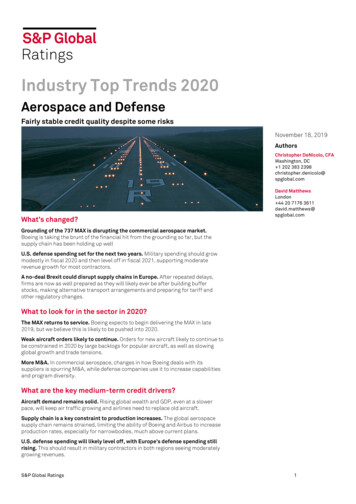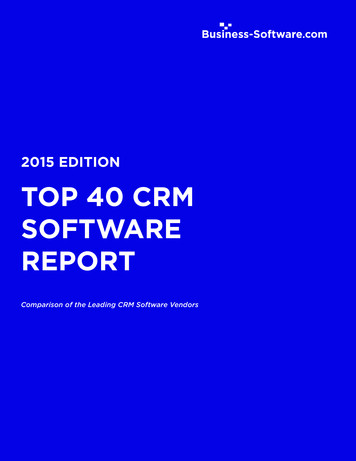
Transcription
Industry Top Trends 2020Aerospace and DefenseFairly stable credit quality despite some risksNovember 18, 2019AuthorsChristopher DeNicolo, CFAWashington, DC 1 202 383 2398christopher.denicolo@spglobal.comWhat’s changed?David MatthewsLondon 44 20 7176 3611david.matthews@spglobal.comGrounding of the 737 MAX is disrupting the commercial aerospace market.Boeing is taking the brunt of the financial hit from the grounding so far, but thesupply chain has been holding up wellU.S. defense spending set for the next two years. Military spending should growmodestly in fiscal 2020 and then level off in fiscal 2021, supporting moderaterevenue growth for most contractors.A no-deal Brexit could disrupt supply chains in Europe. After repeated delays,firms are now as well prepared as they will likely ever be after building bufferstocks, making alternative transport arrangements and preparing for tariff andother regulatory changes.What to look for in the sector in 2020?The MAX returns to service. Boeing expects to begin delivering the MAX in late2019, but we believe this is likely to be pushed into 2020.Weak aircraft orders likely to continue. Orders for new aircraft likely to continue tobe constrained in 2020 by large backlogs for popular aircraft, as well as slowingglobal growth and trade tensions.More M&A. In commercial aerospace, changes in how Boeing deals with itssuppliers is spurring M&A, while defense companies use it to increase capabilitiesand program diversity.What are the key medium-term credit drivers?Aircraft demand remains solid. Rising global wealth and GDP, even at a slowerpace, will keep air traffic growing and airlines need to replace old aircraft.Supply chain is a key constraint to production increases. The global aerospacesupply chain remains strained, limiting the ability of Boeing and Airbus to increaseproduction rates, especially for narrowbodies, much above current plans.U.S. defense spending will likely level off, with Europe’s defense spending stillrising. This should result in military contractors in both regions seeing moderatelygrowing revenues.S&P Global Ratings1
Industry Top Trends 2020: Aerospace and DefenseRatings trends and outlookGlobal Aerospace and DefenseChart 1Chart 2Ratings distributionRatings distribution by regionChart 3Chart 4Ratings outlooksRatings outlooks by regionChart 5Chart 6Ratings outlook net biasRatings net outlook bias by regionSource: S&P Global Ratings. Ratings data measured at quarter end. Data for Q4 2019 is end October, 2019We don’t expect many rating changes in 2020 because 73% of outlooks are stable, thenon-stable outlooks have a heavy negative bias. In the U.S., the negative outlooks largelyresult from M&A, as well as sponsor-owned companies’ failure to meet expectations forearnings growth. There could be negative rating actions on aerospace suppliers if Boeingcuts or suspends MAX production. In Europe, we consider the ratings on our largeinvestment-grade issuers to be relatively stable, with one or two exceptions (Roll-Royceand GKN both have a negative outlook due, in part, to their relative exposure to apotential no-deal Brexit). There are several very highly leveraged, niche high yield playerswho could be vulnerable to any additional bottlenecks or disruption to supply chains.S&P Global RatingsNovember 18, 20192
Industry Top Trends 2020: Aerospace and DefenseCommercial AerospaceKey assumptions1. Boeing resumes MAX deliveries in early 2020Our current base case assumes Boeing receives approval from at least the FAA to resumedeliveries of the MAX by January 2020. However, we expect approval from other globalregulators to occur at different times, which will further delay aircraft delivery to thosecountries. We also expect Boeing to increase production from 42 a month to 57 by early2021, and deliver all the aircraft it has produced during the grounding by 2022.2. New aircraft orders likely to remain weakAircraft orders have declined dramatically in 2019 and we expect this trend to continue in2020. Boeing has received no new firm orders for the MAX since the grounding and isunlikely to receive any significant orders until the aircraft is flying again, likely in early2020. Overall demand will likely remain weak due to the long wait for popular aircraft, aslowing global economy, and trade tensions. However, air traffic growth remains good,despite a recent slowdown, and the ongoing need for airlines to replace their existingaircraft with new, more fuel-efficient models.3. Margin and cash flow should improveAlthough the impact on most suppliers has been modest, the MAX grounding has resultedin slower margin improvement than we had expected because many suppliers arecarrying costs to produce 57 aircraft a month, which will likely not happen until late 2020or early 2021. Margins and cash flow should improve as Boeing increases MAX productionrates and suppliers reduce costs and improve operating efficiency. This improvementcould be offset by pricing pressures from the original equipment manufacturers (OEMs).Similarly, cash flow should improve as the pace of production rate increases slow,reducing the need for capital expenditures and working capital.Despite weak orders and an uptick in cancellations (almost 300 total between Boeing andAirbus in the first nine months of 2019), backlogs for most aircraft should supportproduction-rate targets for the next 12-24 months. Therefore, we expect overall aircraftproduction to spike in 2020 as MAX deliveries resume, return to the level we would haveexpected prior to the MAX grounding in 2021 and then probably flatten out. Boeingrecently announced that it would be reducing 787 production to 12 a month from 14 amonth (a rate it just reached this year) at the end of 2020 due to weak demand fromChina, which is likely related to the ongoing trade disputes. Development delays in thenew 777X are also resulting in Boeing keeping overall 777 production lower for longerthan we had expected. MAX production is likely to increase to 57 month by late 2020 orearly 2021, but further increases may be on hold.Airbus is responding to its large order book by ramping up production rates for the keyA320 single-aisle program, which dominates the order book. Monthly production is alsostabilizing for the A350 twin-aisle program at 10 since the fourth quarter. Airbus' neo,which are more attractive to airline customers, given better fuel efficiency, have takengood traction in the market. We expect the A330 program to also benefit from increasingorders, with the neo option as the replacement cycle approaches. Airbus has reached it’snear term target of 10 A350s a month and is on track to increase A320neo production to63 a month if supply chain issues are resolved.S&P Global RatingsNovember 18, 20193
Industry Top Trends 2020: Aerospace and DefenseKey risks and opportunities1. Delays to MAX return to service and long term impactsThe grounding of the MAX has gone on longer than we expected and the final approval ofthe updated software by global regulators could be delayed beyond our currentexpectation. If delays continue well into 2020, Boeing could decide to further cut or evensuspend MAX production temporarily. This could result in lower revenues, earnings, andcash flow for many suppliers, weakening the already fragile supply chain. The MAXgrounding is also likely to hinder the aircraft certification process, increasing costs formanufacturers.2. Brexit could exacerbate the current supply-chain constraintsIn 2018, delivery numbers of both the MAX and A320neo were delayed by operationalbottlenecks and delays at the engine manufactures, as well as capacity constraintsfurther down the supply chain and quality concerns with some castings and forgings. Thegrounding of the MAX has enabled both CFM and the engine-component suppliers tocatch up. Airbus is still experiencing delays with the A320neo due to engine supplydelays, specifically for the A321 model. Overall the supply chain remains fragile andadditional disruptions are possible.3. Trade wars and slowing global economyAir traffic in 2018 has trended below the long-term average of 5% due to trade tensionsand slowing economic growth, a trajectory that is likely to continue and could accelerateif the global economy weakens further. So far, the decline has primarily hampered neworders, but airlines could start cancelling or deferring orders as earnings weaken. Thiscould also result in more airline bankruptcies following the high profile failures of WOWair hf., Thomas Cook Airlines Ltd., and Jet Airways Ltd. in 2019. The direct impact of thetrade war with China so far hasn’t resulted in a material increase in costs for suppliers.It’s increasingly unlikely that the FAA and other global regulators will approve theupdated MAX software at the same time, which will complicate Boeing’s ability to deliveraircraft already built during the grounding and new ones coming off the production line.Depending on how much of a lag there is, Boeing could decide to slow production furtheror even temporarily suspend production. Either of these actions could be very disruptiveto the supply chain and result in financial difficulties for smaller suppliers or ones thathave a very large MAX exposure. The supply chain is still strained from years of significantproduction increases and the introduction of new models. As many suppliers are stillproducing at the old rate of 52 a month, there’s also the possibility that they’ll have toreduce production after Boeing resumes MAX deliveries due to too much inventory in thesupply chain.The MAX grounding has brought significant attention to the aircraft-certification processand the role the manufacturers play in performing some of the certification tasks. This islikely to result in changes to the process, at least in the U.S., resulting in a longer andmore costly certification process for all aircraft manufacturers. In addition, the regulatoryauthority in the country where the aircraft was built certified the aircraft in the past, andthis was generally accepted by other countries. After the second MAX crash, many nonU.S. regulators grounded the aircraft before the FAA did and are insisting on certifying theupdated software independently. If this trend continues, it could complicate thecertification process even more for manufacturers.The impact of the trade tensions between the U.S. and China and other countries so farhasn’t had a direct impact on the commercial aerospace industry. Higher tariffs oncertain metals and parts made in China haven’t resulted in a material increase in costsS&P Global RatingsNovember 18, 20194
Industry Top Trends 2020: Aerospace and Defensefor manufacturers. Large jetliners have not been subject to tariffs, but orders from Chinahave likely been put on hold as talks continue. However, trade tensions have contributedto the slowdown in global air traffic growth and a significant decline in the much smallerair cargo market, which will likely remain a constraint on new aircraft orders in 2020.We don’t expect the recent World Trade Organization decision and announcement by U.S.trade officials to impose tariffs on aircraft at a 10% rate to have a long-term impact onthe market or Airbus due to the relatively moderate level of proposed tariffs, andexclusion of all aircraft and their parts assembled in the U.S., which is a significant shareof Airbus' single-aisle aircraft delivered to the U.S. market. Furthermore, a similar casebrought by Europe will likely result in tariffs on U.S. aircraft in 12-18 months, eliminatingthe cost differential for airlines.EU trade officials have indicated they would impose tariffon U.S. goods, including aircraft, as a countermeasure, which would constrain Boeing inthe European market.Airbus has significant business operations in the U.K., including the assembly ofsubstantially all the wings for its commercial aircraft, which are then transported to thecompany's final assembly lines, notably in Toulouse and Hamburg in the EU. In additionto its own production of wings, a no-deal Brexit could disrupt the delivery schedule forengines heading from the U.K. across the channel to final assembly lines in Toulouse (formore information, see “Rolls-Royce PLC Downgraded To 'BBB'; Outlook Negative,” Aug.22, 2019). Airbus has recently highlighted the operational and financial risks that wouldarise if the U.K. left the EU in a disorderly way, without an agreement on the futuretrading relationship between the U.K. and EU. In a disorderly Brexit, we assume thatAirbus would face disruptions to aircraft production, higher working capital investments,penalty payments to customers, and lost turnover. Airbus has mitigated the event bybuilding a one-month buffer stock and ensuring operational readiness in terms ofcustoms, transport, and logistics, as well as financial partners.Chart 7Chart 8Large commercial aircraft ordersLarge commercial aircraft deliveriesBoeingBoeingAirbus*Through 0406081012141618Source: Manufacturers' websites, S&P Global RatingsS&P Global RatingsNovember 18, 20195
Industry Top Trends 2020: Aerospace and DefenseChart 9Base case 737 MAX deliveries and productionBacklog 005001/194/197/19 10/19 1/204/207/20 10/20 1/214/217/21 10/21 1/224/227/22 10/22Source: S&P Global RatingsS&P Global RatingsNovember 18, 20196
Industry Top Trends 2020: Aerospace and DefenseU.S. DefenseKey assumptions1. Increasing revenue as defense spending risesOverall military spending was set by the U.S. Congress earlier this year, which will resultin an increase of 3% in fiscal 2020 to 738 billion (including funding for nuclear weaponsat the Department of Energy) and then a more modest bump of less than 0.5% in fiscal2021 to 741 billion. Due to the lag between when money is appropriated by Congressand actually spent by the military, mos
Industry Top Trends 2020 Aerospace and Defense Fairly stable credit quality despite some risks What’s changed? Grounding of the 737 MAX is disrupting the commercial aerospace market. Boeing is taking the brunt of the financial hit from the grounding so far, but the supply chain has been holding up well U.S. defense spending set for the next two years. Military spending should grow modestly .











